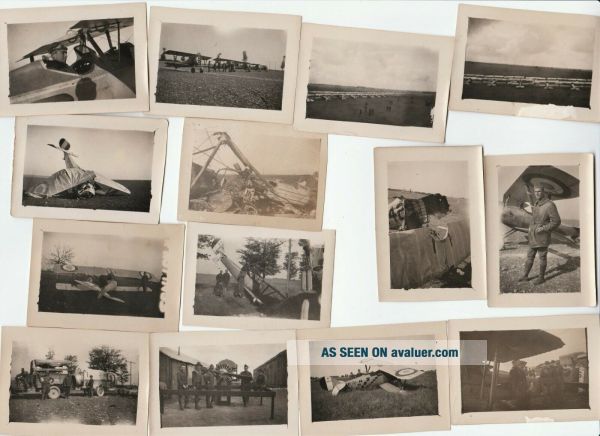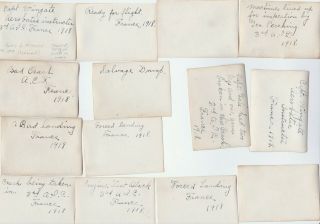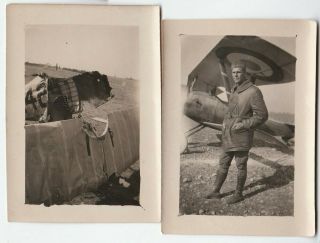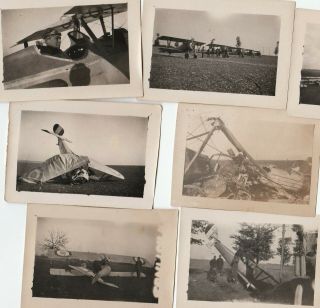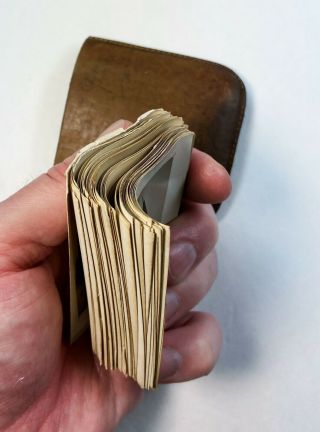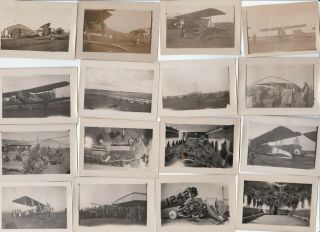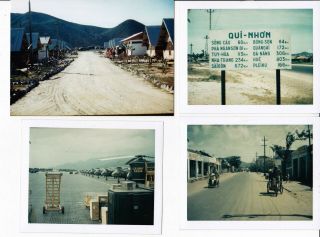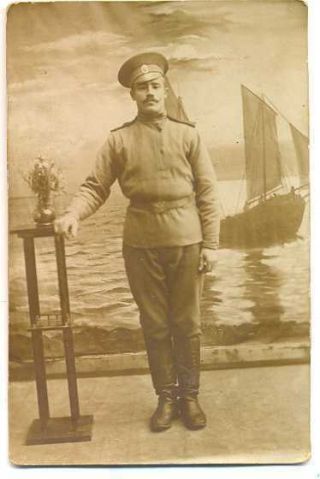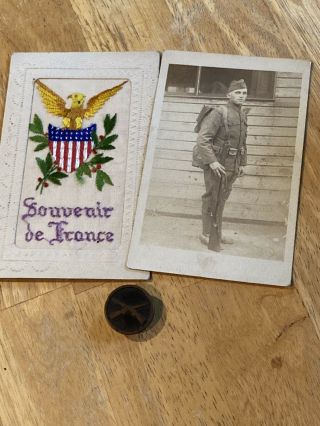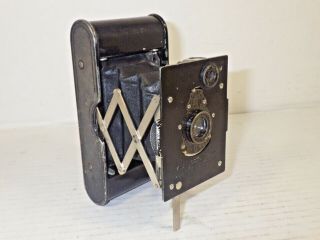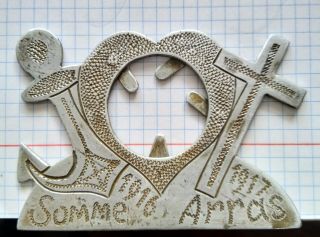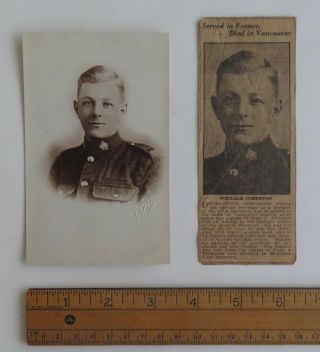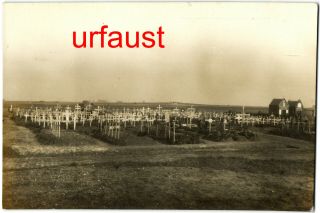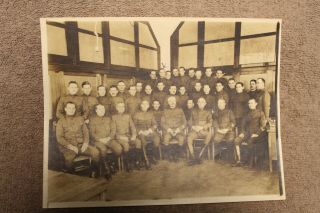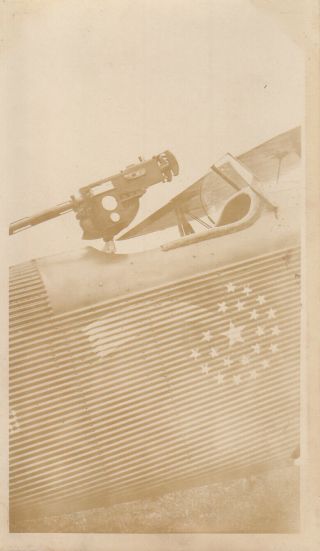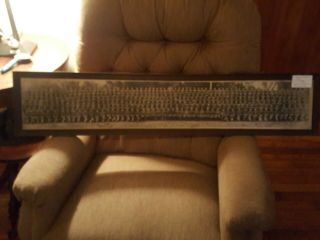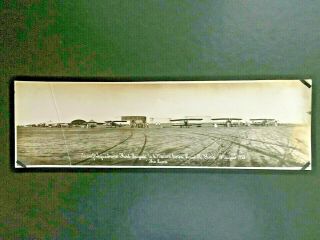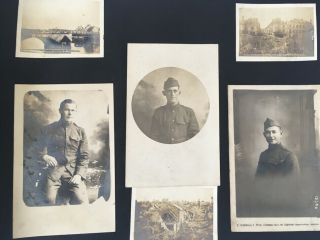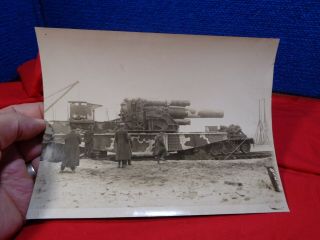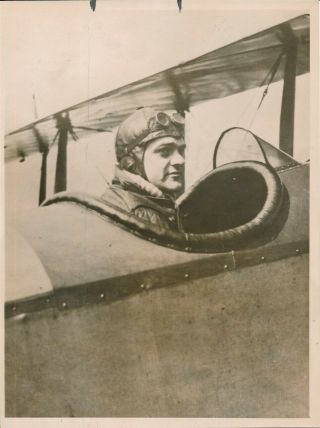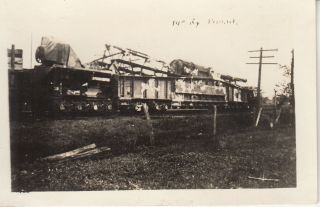WWI Soldier ' S Photo Archive - 3rd Aviation Airplanes 1918 Issoudun France
Item History & Price
| Reference Number: Avaluer:49920943 | Region of Origin: United States |
| Theme: Militaria | Modified Item: No |
| Original/Reproduction: Original | Country/Region of Manufacture: United States |
| Conflict: WW I (1914-18) |
SUPER Photograph COLLECTION Archive
UNIQUE Photos found in a leather pouch - all kept intact
Never seen before
3rd Aviation Instruction Center
Issoudun, France
Harry Wingate shown, Pershing, airplanes, crashes, etc.
1918
For offer, a nice lot of original photos. Fresh from a prominent estate in Upstate, NY. Never offered on the market until now. Vintage, Old, Original - NOT Reproductions - Guaranteed !! Interesting historical ...images. This little pouch of photos is exactly as it was found in an old estate. 56 photos total in small leather pouch. Most are identified on back in manuscript writing by soldier. As of now, I do not know the name of the soldier who took the photos. Shown in photos are Harry L. Wingate, the famous instructor and pilot at the 3rd Aviation Instruction Center in France. He is said to have trained 75% of pilots in WWI. Also shown is a plane crashed by a Captain Gale, who had two legs and one arm broken in the crash. General Pershing shown in distance inspecting airplanes, various crashes, buildings, YMCA, etc shown. One photo dated 1917, en route to France. The rest are 1918. One shows Postman in France; others show railroad and street scenes, etc. More research needs to be done on this group.Each photo measures 3 1/8 x 2 1/4 inches - small snapshots. Harry Lynwood Wingate Sr. was born in 1894 in the Hopeful community, Georgia. On July 15, 1920 he married Miss Ruth Spence who was once Pelham County's "Citizen of the Year". In the early years after the Great War, "The Major" (6 ft. 2 3/4 in. in height), as he was affectionately called, was active in farming and politics. He Served the county as a representative in the Georgia Legislature from 1920-22, and from 1934-41, he was postmaster for the Pelham Post Office, resigning this position when he became President of Georgia Farm Bureau, serving in that capacity until 1958. He was a graduate of the University of Georgia, class of 1917, entering service on May 11, 1917. He served overseas from November 2, 1917 to May 24, 1919 where he taught stunt flying to pilots going to the front to engage the enemy. After the signing of the Armistice, he was in charge of dismantling Issoudun Field and was discharged from service June 16, 1919 at Ft. Oglethorpe, GA. as a Major, Air Service.Collection is in very good condition. Photos have a "wave" light bend to them, and were all stored in the pouch shown in last photos. Please see photo for details. If you collect 20th century American history, military, photography, soldiers, French, etc. this is a treasure you will not see again! Add this to your image or paper / ephemera collection. Combine shipping on multiple bid wins! 2421
Issoudun Aerodrome was a complex of military airfields in the vicinity of Issoudun, Centre, France. They were used during World War I as part of the Third Air Instructional Center, American Expeditionary Forces for training United States airmen prior to being sent into combat on the Western Front.
It was at that time the largest air base in the world. Today the entire complex consists of agricultural fields, the military facility totally obscured with no trace of its wartime history.
HistoryBackgroundBy the summer of 1917, two and a half years of the air war had begun to take a serious toll on the number of French and British aviators. While the United States possessed a relatively enormous pool of human resources, she lacked the well developed training methods and aircraft production capabilities of the Allies. In order to maximize the resources of both, the French submitted a memorandum to General George O. Squier, then the Chief Signal Officer of the U.S. Army, suggesting the establishment of an American advanced flying school in France.[1]
The site decided upon for this advanced aviation school was Issoudun, France. Issoudun, located about 100 miles southeast of Paris, was primarily chosen because the surrounding countryside was extremely level and relatively sparsely populated with wide-open spaces for flying fields. The site was also relatively close to a major government-owned railroad line. Probably just as important was its proximity to the aviation factories and new plane assembly fields in the south which were to supply the aircraft to be used in the training at Issoudun. In spite of the advantages of this location, significant work was required to bring the Third Aviation Instruction Center (3rd AIC), as it was to be named, to life.[1]
Eddie Rickenbacker, Douglas Campbell, and Kenneth Marr of the 94th Aero Pursuit Squadron all trained at IssoudunWhen General John J. Pershing first saw the site it was nothing but a series of flat fields, with no barracks, hangars, buildings or classroom facilities. Under the agreement with the French, the United States was, “…to furnish 200 workman to erect it (3d AIC) and ‘all the tools, nails and other implements necessary, ’ including a narrow-gauge railroad, while France was to furnish the planes, motors and suitably cleared land.” With this accomplished, American pilots were to begin training in July of 1917 and be ready for the front in the fall of the same year.[1]
While this proposal was approved by Pershing, it met some resistance when it reached the Secretary of War. With an initial price tag of almost $800, 000 just to open the field, the proposal was rejected by the Secretary of War on 19 May 1917. That same day the proposal was resubmitted with the additional argument that a facility such as the 3d AIC was critical to the development of the air forces that would accompany the A.E.F. to Europe. This time the proposal was accepted and by July 1917 the first Aero Construction Squadrons began to arrive in France.[1]
By early fall of that same year construction at the field was in full-swing. While the initial pace of building was hectic in an effort to make the base operational as quickly as possible, construction at Issodun was never really completed and continued right up to the 1918 Armistice with Germany. As a result of this furious pace of construction, Issodun was fully operational and training was being conducted within a months of Pershing accepting the base.[1]
3d Air Instructional Center
Morane rouleur high-speed taxiing trainer on Field 1The 3d AIC at Issodun was initially to be merely a “refresher course” for American pursuit pilots arriving in France, prior to being sent to the front. The intent was for the American pilots, having already received advance training in the United States, to become acquainted with the current tactics and aircraft being used at the front.[1]
The advanced aviation schools in the U.S. were slow to develop and lacked both aircraft of the type being used at the front and pilots with combat experience to act as instructors. This lack of advance training in the U.S. dictated the development of a complete course in advanced flying and aerial tactics at Issodun.[1]
Initially, the school was initially staffed primarily by French instructors, used French airplanes, and consequently, followed the French Bleriot system of instruction. At the time, America did not have the time, resources or pilots to establish its own program in France and therefore relied totally on the French to prepare American pilots for combat duty. American pilots with combat experience and flying time in the type of aircraft being flown at the front were a rare commodity. Many of them were flying with French units, or the Lafayette Escadrille, and chose to remain with those units rather than join the A.E.F. Gradually, American pilots, either graduates from Issodun or from the American front-line units began to replace their French counterparts. Even with this gradual transition though, the training program at Issodun remained fundamentally the Bleriot system. The various fields at Issodun (initially nine, later expanded to 15) each provided a different phase of instruction, allowing the student to progress in successive stages of training until adequately prepared to participate at the front.[1]
Issoudun Aerodrome - Main area.jpg
Field 5 showing Nieuport 15M, 80 HP and 120 HP aircraftThe student's progression through these fields was typically as follows:[2][3]
Main AerodromeField 1, 46°59′50″N 001°51′58″E[3] Rouleur Field; Primary instruction, high speed taxiingField 2, 47°00′26″N 001°52′27″E[3] Main Field, Dual-control instruction, first solo flightField 3, 47°00′47″N 001°53′02″E[3] Solo Flying, Cross Country, basic aerobaticsThe main aerodrome were also used for new aircraft delivered to the base and the major hangar repair field, for testing repaired or rebuilt aircraft[4]
Field 4, 47°00′15″N 001°54′27″E[3] Used for spiral turnsField 5, 47°00′27″N 001°56′11″E[3] Used for taxiing, taking off, and landing and wing slipsField 6, 46°59′12″N 001°55′20″E[3] Aerobatic Field; Used for advanced acrobaticsFields #4, #5, #6 were used for basic flight training[4]
Field 7, 46°56′49″N 001°53′33″E[3] Valentine Field, Used for training in formation flying[4]Field 8, 46°57′45″N 001°50′22″E[3] Used for aerial combat trainingField 9, 47°01′50″N 001°49′35″E[3] Introduction to the Nieuport 18M (Graduates either proceeded to Field 10 for 2-seater training or to Field 4 for pursuit training)Field 10, 46°58′10″N 001°54′16″E[3] Used for observation pilot training (DH 4)Field 11, 46°56′08″N 001°50′39″E[3] Under Construction 1 October 1918, not used[4]Field 12, 47°00′51″N 001°48′35″E[3] Under Construction 1 October 1918, not used[4]Field 13, 47°01′21″N 001°53′03″E[3] Under Construction 1 October 1918, not used (planned for aerial gunnery)[4]Field 14, 46°57′10″N 001°46′45″E[3] Used for machine gun training in aerial gunnery[4]Field 15, 47°02′39″N 001°58′31″E[3] Under Construction 1 October 1918, not used[4]Operating the 3rd Aviation Instruction Center required a large number of organizations. Serving at Issoudun were the following U.S. Aero Squadrons: 10th, 21st, 26th, 30th, 31st, 32nd, 33rd, 35th, 37th, 43rd, 101st, 149th, 158th, 173rd, 257, 369th, 372nd, 374th, 640th, 641st, 642nd, 644th, 801st, 802nd, and 1104th.[2]
When the first students of the school at Issodun reported for duty to the front they were among the most extensively trained pilots of the day. The average American pilot received about 60 hours of training at Issodun and by the time he had completed aerial gunnery school, he averaged over 100 hours of training, “…nearly triple the number of hours of flying time with which pilots of the Royal Air Force had been reporting to their combat units two years earlier.” [1]
When the Armistice was signed on 11 November 1918, Issodun was the largest flying school in the world. More than 1, 800 men had attended advanced training at Issodun, of whom 829 completed the pursuit course, 627 served in combat against the Germans on the Western Front, and 202 became instructors. The combat record of those who went to the front speaks for itself—781 enemy planes and 73 balloons destroyed at the cost of 289 aircraft and 48 balloons lost by the AEF.[1]
ClosureThe United States Air Service formally left Issoudun Airdrome on 28 June 1919 almost eight months after the war ended. The sites of the former airfields have returned to their previous status as agricultural fields.
On 28 June 2009, the people of Issoudun had a commemoration ceremony in honor of the American aviators who had trained, and in many cases, died while training there. A single monument on Department Route 960 remains to mark Issoudun's part in the Great War.
Training aircraft used
Nieuport 28 shown on Issoudun Field 8Morane rouleurs (preliminary training ground training aircraft, fitted with clipped wings)De Haviland DH-4Nieuport 15MNieuport 18MNieuport 23Nieuport 24Nieuport 28[2]
Known squadrons assigned95th Aero Squadron (Pursuit), 16 November 1917 – 18 February 1918103d Aero Squadron (Pursuit), 24 December 1917 – 18 February 191894th Aero Squadron (Pursuit), 24 January - 5 March 191813th Aero Squadron (Pursuit), 27 January - 11 May 191827th Aero Squadron (Pursuit), 29 March-24 April 1918139th Aero Squadron (Pursuit), 29 March-28 May 191828th Aero Squadron (Pursuit), 24–27 June 191822d Aero Squadron (Observation), 26 June-7 July 191849th Aero Squadron (Pursuit), 2–28 July 191893d Aero Squadron (Pursuit), 7–28 July 1918135th Aero Squadron (Observation), 2–19 July 19181st Aero Squadron (Observation), 29 September-19 October 1918[4] [5] [6]
See alsoicon World War I portalList of United States Air Service aerodromes in FranceChâteauroux-Déols Air Base Cold War USAF NATO depot Air Base located 13 miles southwest of Issoudun Aerodrome Complex.Location Map of Issoudun Aerodromes
The Organization of the Air Service of the American Expeditionary Force on November 11, 1918, represents its maximum strength in World War I. Units of the Air Service are listed as assigned to the order of battle for that date, which was that of the Armistice with Germany. The first air unit arrived in France in September 1917, while the final air unit reaching the front did so on November 9, 1918. Unit operations began in April 1918. At the armistice, 57, 508 officers and men served in the Air Service of the AEF, 24, 512 in the Zone of Advance (combat area), and 32, 996 in the Services of Supply (rear areas). Of its 6, 861 officers, 4, 088 were on flying status and 219 were qualified observation balloon aviators. 1, 724 of those on flying status and approximately 100 of the balloonists served in combat units.[1]
The First Army Air Service was activated August 26, 1918, with Col. Benjamin Foulois named chief over Col. Billy Mitchell. The Second Army Air Service was activated on October 12 with Col. Frank P. Lahm as chief, and the Third Army Air Service was created immediately after the armistice to provide aviation support to the army of occupation, primarily from veteran units transferred from the First Army Air Service.
The first two air combat groups formed in the AEF were the 1st Corps Observation Group, in April 1918, and the 1st Pursuit Group at Toul. Ultimately fourteen airplane and seven balloon groups were formed to support the operations of two field armies and five corps. The five pursuit and two bombardment groups were organized into two wings. The seven observation and seven balloon groups had one of each assigned to an army or corps air service. Two flexible "observation wings" were created to coordinate the reconnaissance activities of the five corps air services.
The basic units of the air service were the squadron for powered aircraft and the company for balloons. 45 squadrons (38 of which conducted combat operations) of aircraft and 17 companies of balloons served at the front. The 20 pursuit and seven bombardment squadrons were authorized 25 aircraft (including spares) and 18 crews each by the Field Service Regulations, while the 18 observation squadrons were each authorized 24 planes and 18 crews. Balloon companies were equipped with one balloon and approximately six observers each.
Air Service of the American Expeditionary Force (AEF)
General William Mitchell's personal Spad XVIHeadquarters Air Service, Zone of AdvanceHeadquarters, Chief of Air Service, AEF (Chaumont Hill 402 Aerodrome[2]).Major General Mason M. PatrickHeadquarters, Chief of Air Service, Group of Armies (Ligny-en-Barrois)Brigadier General William L. "Billy" MitchellFirst Army Air ServiceThe First Army Air Service was the largest and most diverse Air Service combat organization of the American Expeditionary Forces in France, and most American Air Service combat units were assigned to it when assigned to the front. The First Army Air Service dates to the first American Air Service personnel arriving in France. On 15 January 1918, Colonel William Mitchell was appointed Chief of the Air Service, I Corps, First Army. At this time, the I Corps was being formed for the purpose of administratively handling all of the American troops then on the Western Front. Headquarters was located at Neufchâteau, France. When the first American Aero Squadrons arrived at the front in April 1918, they were assigned to the quiet Toul Sector. At this time, the American Air Service on the front consisted of only a few Aero Squadrons of the 1st Pursuit Group.[3]
Created on 10 August at La Ferté-sous-Jouarre, the unit was formally organized on next 26 August at Ligny-en-Barrois, France. It consisted of the French Aerial Division, which consisted of a large number of pursuit and day bombardment squadrons. In addition, there was one other French pursuit group and three American pursuit groups-one American day-bombardment group-the 1st Army observation, and one French Army artillery group for the adjustment of long-range artillery fire. Eight night-bombardment squadrons of the British Royal Air Force. were to cooperate with the First Army Air Service whenever the tactical situation made such action expedient. The establishment of the First Army Air Service marked the first concentration of American air forces under its own commander.[4]
On 11 November 1918, all offensive flying ended at 11:00 am in compliance with the Armistice with Germany. As part of the Armistice, Allied Forces were to occupy the Rhineland area of Germany beginning on 1 December. The Third Army Air Service was established to be the air component of the United States Third Army. Units from the First Army AS contributed to over half the strength of Third Army AS, consisting of eight Aero Squadrons, and the headquarters of the III Corps Observation Group, and the VII Corps Observation Group.[5]
Headquarters was officially demobilized on 15 April 1919, its men arriving in the United States by the end of May and either transferred to Air Service units or returned to civilian life.[6]
11th Aero Squadron posing with its De Havilland DH.4 Bombers (Note "Mr Jiggs" on each fuselage), Maulan Aerodrome
Caquot Type "R" kite balloon
1st Aero Squadron Salmson 2.A2 reconnaissance aircraft, Remicourt Aerodrome
135th Aero Squadron De Havilland DH.4 No 4, Saizerais Aerodrome
27th Aero Squadron - 2lt Frank Luke Jr with his SPAD XIII, Rembercourt Aerodrome
Eddie Rickenbacker, Douglas Campbell, and Kenneth Marr of the 94th Aero Squadron pose next to a Nieuport 28 fighter, 1918.HQ First Army Air Service, 10 August 1918 – 15 April 1919 (La Ferté-sous-Jouarre, then Ligny-en-Barrois 26 August, and Souilly Aerodrome 21 September)Colonel Thomas D. Milling, Commander[7]First Day Bombardment Group 10 September 1918 – 17 December 1918[8] (Amanty Aerodrome, then 23 September to Maulan Aerodrome)Major James L. Dunsworth, Commander[7]11th Aero Squadron (Day Bombardment) 10 September 1918-17 December 1918 (De Havilland DH.4)20th Aero Squadron (Day Bombardment) 10 September 1918-17 December 1918 (De Havilland DH.4)96th Aero Squadron (Day Bombardment) 10 September 1918-17 December 1918 (Breguet 14B.2)166th Aero Squadron (Day Bombardment) 20 September 1918-21 November 1918 (De Havilland DH.4)First Army Observation Group 6 September 1918 – 15 April 1919 (Vavincourt Aerodrome)Captain Harry T. Wood, Commander[7]9th Aero Squadron (Night Observation) 26 Aug 1918-15 November 1918 (Breguet 14A.2)24th Aero Squadron (Army Observation) 14 Aug 1918-15 April 1919 (Salmson 2.A2)91st Aero Squadron (Army Observation) 7 May 1918-27 December 1918 (Salmson 2.A2)186th Aero Squadron (Army Observation) 27 Oct 1918-10 April 1919 (Salmson 2.A2)First Army Balloon Group[7]Major John Paegelow, Commander11th Balloon Company (Fontaines)43d Balloon Company (Fossé)I Corps Observation Wing (Rampont)Major Melvin Adams Hall, Commander[7]I Corps Observation Group 21 April 1918 – 15 April 1919 (HQ: see page)1st Aero Squadron (Corps Observation) 21 April 1918-18 November 1918 (Salmson 2.A2)12th Aero Squadron (Corps Observation) 30 April 1918-20 November 1918 (Salmson 2.A2)88th Aero Squadron (Corps Observation) 28 May 1918-25 July 1918 (Salmson 2.A2)50th Aero Squadron (Corps Observation) 8 September 1918-1 April 1919 (De Havilland DH.4)90th Aero Squadron (Corps Observation) 15 November 1918-18 January 1919 (Salmson 2.A2)I Corps Balloon Group (Chéhéry)1st Balloon Company (Auzéville)2d Balloon Company (Les Petites-Armoises)5th Balloon Company (La Besace)III Corps Observation Wing (Dun-sur-Meuse)Major Joseph C. Morrow, Commander[7]III Corps Observation Group 20 September 1918 – 21 November 1918 (Souilly Aerodrome, 29 October 1918 to Bethelainville Aerodrome)Captain Kenneth P. Littauer, Commander88th Aero Squadron (Corps Observation) 24 May 1918-15 November 1918 (Salmson 2.A2)90th Aero Squadron (Corps Observation) 11 June 1918-15 November 1918 (Salmson 2.A2)1st Aero Squadron (Corps Observation) 18-21 November 1918 (Salmson 2.A2)III Corps Balloon Group (Dun-sur-Meuse)3d Balloon Company (Belrupt)4th Balloon Company (Vilosnes-sur-Meuse)9th Balloon Company (Consenvoye)42d Balloon Company (Villers-devant-Dun)IV Corps Observation Group 1 July-14 October 1918 (HQ: see page)[7]135th Aero Squadron (Corps Observation), 30 July 1918-14 October 1918 (De Havilland DH.4)24th Aero Squadron (Corps Observation), 6-22 August 1918 (Salmson 2.A2)8th Aero Squadron (Corps Observation), 31 August 1918-14 October 1918 (De Havilland DH.4)V Corps Observation Wing (Nouart)Major Martin F. Scanlon, Commander[7]V Corps Observation Group 1 September 1918 – 15 February 1919 (see page)99th Aero Squadron (Corps Observation) 7 September 1918-15 February 1919 (Salmson 2.A2)104th Aero Squadron (Corps Observation) 4 September 1918-14 January 1919 (Salmson 2.A2)88th Aero Squadron (Corps Observation) attached 12-17 September 1918 (Salmson 2.A2)V Corps Balloon Group (Nouart)[7]Captain Alvin C. Rois, Commander6th Balloon Company (Brabant-sur-Meuse)7th Balloon Company (Tailly)8th Balloon Company (Nouart)12th Balloon Company (Buzancy)VII Corps Observation Group 7 August 1918[9] – 14 November 1918[7] (HQ: see page)258th Aero Squadron (Corps Observation) 19 September 1918-7 November 1918 (Salmson 2.A2)278th Aero Squadron (Corps Observation) 29 October 1918-14 November 1918 (De Havilland DH.4)1st Pursuit Wing 6 July 1918 – 17 December 1918[10][11] (HQ: see page)Major Burt M. Atkinson, Commander(from 5 May to 6 July, the three PG are directly under command on the First Army Air Service)1st Pursuit Group 5 May 1918 – 9 December 1918 (HQ: see page)[7]Major Harold E. Hartney, Commander27th Aero Squadron (Pursuit) 2 June 1918 - 9 December 1918 (SPAD S.XIII)94th Aero Squadron (Pursuit) 5 May 1918 - 20 November 1918 (SPAD S.XIII)95th Aero Squadron (Pursuit) 5 May 1918 - 9 December 1918 (SPAD S.XIII)147th Aero Squadron (Pursuit) 2 June 1918 - 9 December 1918 (SPAD S.XIII)185th Aero Squadron (Night Pursuit) 5 October 1918 - 9 December 1918 (Sopwith Camel F.1)2d Pursuit Group 29 June 1918 – 11 December 1918 (see page)[7]Major Davenport Johnson, Commander13th Aero Squadron (Pursuit) 28 June 1918 – 5 December 1918 (SPAD S.XIII)22d Aero Squadron (Pursuit) 16 August 1918 – 11 December 1918 (SPAD S.XIII)28th Aero Squadron (Pursuit) 6 November 1918 - 11 December 1918 (SPAD S.XIII)49th Aero Squadron (Pursuit) 2 August 1918 – 5 December 1918 (SPAD S.XIII)103rd Aero Squadron (Pursuit) 4 July 1918 - 7 August 1918 (SPAD S.XIII)139th Aero Squadron (Pursuit) 30 June 1918 – 11 December 1918 (SPAD S.XIII)3d Pursuit Group 26 July 1918 – 31 December 1918 (see page)[7]Major William Thaw II, Commander28th Aero Squadron (Pursuit) 22 August 1918 - 6 November 1918 (SPAD S.XIII)49th Aero Squadron (Pursuit) 28 July 1918 - 2 August 1918 (SPAD S.XIII)93d Aero Squadron (Pursuit) 26 July 1918 - 15 December 1918 (SPAD S.XIII)103d Aero Squadron (Pursuit) 7 August 1918 - 31 December 1918 (SPAD S.XIII)213th Aero Squadron (Pursuit) 26 July 1918 - 31 December 1918 (SPAD S.XIII)Second Army Air Service
Headquarters staff, Second Army Air Service, Croix-de-Metz Aerodrome (Toul), France, November 1918The Second Army Air Service was established on 14 October 1918 by General Order, 287, GHQ. Paragraph 170 appointed Colonel Frank P. Lahm as Chief of Air Service, Second Army, thus establishing a separate Air Service organization. Headquarters was established at Croix-de-Metz Aerodrome, Toul, France.[3]
As a result of the Armistice with Germany, American occupation forces would be sent to the German Rhineland. The Third Army Air Service, under the command of Brigadier General William Mitchell was organized on 14 November as the Air Service component of Third Army. First and Second Army Air Services were ordered to transfer some of their units at the front to Third Army as part of its organization, along with personnel from their Headquarters staffs along with the required equipment, ranging from office furniture to airplanes. The 5th Pursuit Group was transferred to Third Army on 19 November, along with the 41st, 138th and 638th Aero Squadrons.[12]
On 15 April 1919, orders were received from Paris that the Second Army Air Service was to demobilize. The 85th, 141st, 168th, 258th, 278th, and 354th Aero Squadrons were transferred to Third Army, with the remainder of its organizations to report to the Services of Supply 1st Air Depot to turn in their equipment. After being processed at Colombey, personnel were assigned to the commanding general, Services of Supply, and sent to one of several staging depots in France where they awaited transport back to the United States and subsequent return to civilian life.[12]
De Havilland DH.4 of the 354th Aero Squadron flying over the front line trenches in the Toul Sector, France, November 1918.
Squadron Emblem, painted on the fuselage of a De Havilland DH.4.
Royal Aircraft Factory S.E.5a's, 25th Aero Squadron enlisted corps with squadron commander Capt Reed Landis, Croix-de-Metz Aerodrome 1918
Joseph "Child Yank" Boudwin with mechanics and his last S.E. 5a, "19" of the 25th Aero SquadronHQ Second Army Air Service, 12 October 1918 – 15 April 1919 (Croix-de-Metz Aerodrome) (Toul)Colonel Frank P. Lahm, Commander [7]Second Army Observation Wing (Croix-de-Metz Aerodrome) (Toul)[7]278th Aero Squadron (Army Observation), 14–21 November 1918Second Army Observation Group 25 October-4 November 1918 (Chaumont Hill 402 Aerodrome)Major C. Delaney, (attached from French Third Army), Commander85th Aero Squadron (Army Observation), 25 October-4 November 1918 (Chaumont-Hill 402 Aerodrome, De Havilland DH.4)Escadrilles Sal.28, Spa.47, and Spa.277, Aéronautique Militaire - (Saint-Mihiel Aerodrome) (Salmson 2.A2 and SPAD S.XIII)IV Corps Observation Group 14 October-21 November 1918 (see page)Major Harry B. Anderson, Commander [7]8th Aero Squadron (Corps Observation), 14-23 October 191885th Aero Squadron (Corps Observation), 4–21 November 1918 (Salmson 2.A2)88th Aero Squadron (Corps Observation), 15–21 November 1918 (Salmson 2.A2)135th Aero Squadron (Corps Observation), 14 October-21 November 1918 (De Havilland DH.4)168th Aero Squadron (Corps Observation) 14 October 1918-21 November 1918 (De Havilland DH.4)258th Aero Squadron (Corps Observation), 10–21 November 1918 (Salmson 2.A2)VI Corps Observation Group 14 October-15 April 1919 (Saizerais Airfield)Major Joseph T. McNarney, Commander [7]8th Aero Squadron (Corps Observation), 23 October1918-21 November 1918 (Salmson 2.A2)354th Aero Squadron (Corps Observation) 14 October 1918-15 April 1919 (De Havilland DH.4)2d Day Bombardment Group 1 November 1918 – 15 April 1919 (Ourches Aerodrome)Major George E. A. Reinberg, Commander [7]100th Aero Squadron (Day Bombardment) 1 November 1918-15 April 1919 (De Havilland DH.4)163d Aero Squadron (Day Bombardment) 1 November 1918-15 April 1919 (De Havilland DH.4)4th Pursuit Group 26 October 1918 – 15 April 1919 (Croix-de-Metz Aerodrome) (Toul)Major Charles J. Biddle, Commander [7]17th Aero Squadron (Pursuit) 4 November 1918 - 12 December 1918 (SPAD S.XI)25th Aero Squadron (Pursuit) 27 October 1918 - 15 April 1919 (RAF S.E. 5a)141st Aero Squadron (Pursuit) 27 October 1918 - 15 April 1919 (SPAD S.XIII)148th Aero Squadron (Pursuit) 4 November 1918 - 15 April 1919 (SPAD S.XI)5th Pursuit Group 15 November 1918 – 15 April 1919 (Lay-Saint-Remy Aerodrome)Captain Dudley L. Hill, Commander [7]41st Aero Squadron (Pursuit), 15 November 1918-15 April 1919 (Sopwith Camel F.1)138th Aero Squadron (Pursuit), 15 November 1918-15 April 1919 (Sopwith Camel F.1)638th Aero Squadron (Pursuit), 15 November 1918-15 April 1919 (Sopwith Camel F.1)Second Army Balloon Wing (Croix-de-Metz Aerodrome) (Toul)[7]Major John H. Jouett, Commander(Six companies en route to front)20 and 52 Balloon Companies, Aéronautique MilitaireIV Corps Balloon Group[7]15th, 18th, & 69th Balloon CompaniesVI Corps Balloon Group[7]10th Balloon CompanyThird Army Air ServicePromptly after the armistice, the AEF formed the Third United States Army to march immediately into Germany while the remainder of the army demobilized. Brig. Gen. Mitchell was appointed to command the Third Army Air Service, on November 14, 1918.[13] Gen. Mitchell was replaced in January as commander of the Third Army Air Service by Col. Harold Fowler, a combat veteran of the Royal Flying Corps and former commander of the American 17th Pursuit Squadron.
The most veteran units of the Air Service were selected to form the new Air Service. A pursuit unit, the 94th Aero Squadron; a day bombardment squadron, the 166th; and four observation squadrons (1st, 12th, 88th, and 9th Night) were initially assigned.[14]
91st Aero Squadron - Coblenz Airfield, January 1919 medals ceremony.
9th Aero Squadron - evaluating a captured Fokker D.VII, Trier Aerodrome
Major Reed Chambers, AEF 94th Pursuit Squadron next to a SPAD S.XIII, Coblenz Aerodrome
Members of the 1st Aero Squadron enjoying some R&R on a Rhine River Cruise, spring 1919HQ Third Army Air Service, 14 November 1918 – 2 July 1919[15] (HQ: see page).9th Aero Squadron (Night Observation), 21 November 1918-15 April 191991st Aero Squadron (Observation), 21 November 1918-15 April 191994th Aero Squadron (Pursuit), 21 November 1918-15 April 1919166th Aero Squadron (Day Bombardment), 21 November 1918-15 April 191924th Aero Squadron (Corps Observation), 12 May 1919-18 July 1919138th Aero Squadron (Pursuit), 12 May-1 July 1919III Corps Observation Group, 21 November 1918 – 12 May 1919[15] (HQ: see page) (Salmson 2.A2)1st Aero Squadron (Corps Observation), 21 November 1918-12 May 191924th Aero Squadron (Corps Observation), 15 April 1919-12 May 1919168th Aero Squadron (Corps Observation), 15 April 1919-12 May 1919258th Aero Squadron (Corps Observation), 15 April 1919-12 May 1919III Corps Balloon Group (Urbar)1st, 3rd, 14th, 24th, and 44th Balloon CompaniesIV Corps Observation Group, 21 November 1918 – 12 May 1919 [15] (HQ: see page) (Salmson 2.A2)12th Aero Squadron (Corps Observation), 21 November 1918-15 April 191988th Aero Squadron (Corps Observation), 21 November 1918-6 December 191885th Aero Squadron (Corps Observation), 15 April 1919-12 May 1919278th Aero Squadron (Corps Observation), 15 April 1919-12 May 1919354th Aero Squadron (Corps Observation), 15 April 1919-12 May 1919VII Corps Observation Group, 14 November 1918 – 12 May 1919 [15] (HQ: see page) (Salmson 2.A2)9th Aero Squadron (Night Observation), 15 April 1919-12 May 1919 (De Havilland DH.4)88th Aero Squadron (Corps Observation), 6 December 1918-12 May 1919186th Aero Squadron (Corps Observation), 15 April 1919-12 May 19195th Pursuit Group, 15 April 1919 – 12 May 1919 [15]Coblenz Aerodrome (Sopwith F-1 Camel)41st Aero Squadron (Pursuit), 15 April 1919-12 May 1919138th Aero Squadron (Pursuit), 15 April 1919-12 May 1919141st Aero Squadron (Pursuit), 15 April 1919-12 May 1919638th Aero Squadron (Pursuit), 15 April 1919-12 May 1919On April 15, 1919, the First and Second Army Air Services in France closed down, and the remainder of their personnel were returned to the United States. As a result, the Third Army Air Service was augmented with some of the few squadrons remaining in France. The Third Army Air Service's pursuit squadrons were consolidated at Coblenz. The 1st Aero Squadron and the remaining observation squadrons were consolidated at Weissenthurm and formed the III Corps Observation Group. The IV Corps Observation Group consisted of only the 85th Aero Squadron at Sinzing. The VII Corps Observation Group was at Trier.[15][16]
On 15 May 1919, the Air Service was ordered to demobilize all of its flying units, which reported to the 1st Air Depot, Colombey-les-Belles Aerodrome, France for subsequent transfer to the Services of Supply for processing back to the United States from Channel ports of Embarkation in France. The remaining Air Service units were consolidated at Coblenz, with the other facilities in the Rhineland closed and dismantled. All foreign aircraft were returned to the French and British governments and personnel were demobilized in the United States by the end of July 1919.[15]
American Forces Germany
Weissenthurm Aerodrome, Germany, shown in 1921The Treaty of Versailles officially came into effect in June 1919, and the Third Army Air Service was withdrawn.[17] The Third Army Air Service officially was demobilized on 2 July 1919, [15] and the American Forces Germany (AFG) took over the occupation duties in the Rhineland.[17] In July 1920, it was decided to add an Air Service organization to the forces of the AFG, and on 23 July a detachment of officers and men were deployed to Germany, under the command of Major Frank M. Andrews.[18] They were not assigned to any specific Aero Squadron, but to the AFG directly.
The Air Service personnel were established at Weissenthurm, south of Coblenz on the Rhine River. A new aerodrome was established, and some Bessonneau hangars were erected and quarters were established for personnel and offices. The contingent was equipped with 24 De Havilland DH.4 aircraft, powered by American Liberty engines.[19] In March 1921, Army Engineers had erected facilities on the airfield and the Americans were moved to the airfield from the temporary facilities they occupied in the town during the winter. Occupation duties included all sorts and types of flying, such as test flights, photos of radio telegraph and radio telephone missions, joint flights with infantry, cavalry and artillery units during the winter and spring maneuvers, cross country flights and passenger carrying. A significant amount of aerial photography was taken for cartographic missions, and large mosaics of photos were created.[18]
The postwar occupation mission was not popular with the American people, nor with the Americans sent to Germany, nor with the Germans. In 1922, President Harding began withdrawing American forces from the Rhineland. All AFG aviation activities were shut down in April and all of the excess equipment was disposed of through sales.[19] On 24 January 1923, the last American forces departed from Germany, leaving Coblenz to the French, formally ending the United States involvement in World War I.[17]
See alsoicon World War I portalList of United States Air Service aerodromes in FranceList of World War I flying aces from the United States
World War I (WWI or WW1), also known as the First World War or the Great War, was a global war centered in Europe that began on 28 July 1914 and lasted until 11 November 1918. More than 9 million combatants and 7 million civilians died as a result of the war, a casualty rate exacerbated by the belligerents' technological and industrial sophistication, and tactical stalemate. It was one of the deadliest conflicts in history, paving the way for major political changes, including revolutions in many of the nations involved.[5]
The war drew in all the world's economic great powers, [6] which were assembled in two opposing alliances: the Allies (based on the Triple Entente of the United Kingdom, France and the Russian Empire) and the Central Powers of Germany and Austria-Hungary. Although Italy had also been a member of the Triple Alliance alongside Germany and Austria-Hungary, it did not join the Central Powers, as Austria-Hungary had taken the offensive against the terms of the alliance.[7] These alliances were reorganised and expanded as more nations entered the war: Italy, Japan and the United States joined the Allies, and the Ottoman Empire and Bulgaria the Central Powers. Ultimately, more than 70 million military personnel, including 60 million Europeans, were mobilised in one of the largest wars in history.[8][9]
The immediate trigger for war was the 28 June 1914 assassination of Archduke Franz Ferdinand of Austria, heir to the throne of Austria-Hungary, by Yugoslav nationalist Gavrilo Princip in Sarajevo. This set off a diplomatic crisis when Austria-Hungary delivered an ultimatum to the Kingdom of Serbia, [10][11] and entangled international alliances formed over the previous decades were invoked. Within weeks, the major powers were at war and the conflict soon spread around the world.
On 28 July, the Austro-Hungarians declared war on Serbia and subsequently invaded.[12][13] As Russia mobilised in support of Serbia, Germany invaded neutral Belgium and Luxembourg before moving towards France, leading Britain to declare war on Germany. After the German march on Paris was halted, what became known as the Western Front settled into a battle of attrition, with a trench line that would change little until 1917. Meanwhile, on the Eastern Front, the Russian army was successful against the Austro-Hungarians, but was stopped in its invasion of East Prussia by the Germans. In November 1914, the Ottoman Empire joined the Central Powers, opening fronts in the Caucasus, Mesopotamia and the Sinai. Italy joined the Allies in 1915 and Bulgaria joined the Central Powers in the same year, while Romania joined the Allies in 1916, and the United States joined the Allies in 1917.
The Russian government collapsed in March 1917, and a subsequent revolution in November brought the Russians to terms with the Central Powers via the Treaty of Brest Litovsk, which constituted a massive German victory until nullified by the 1918 victory of the Western allies. After a stunning Spring 1918 German offensive along the Western Front, the Allies rallied and drove back the Germans in a series of successful offensives. On 4 November 1918, the Austro-Hungarian empire agreed to an armistice, and Germany, which had its own trouble with revolutionaries, agreed to an armistice on 11 November 1918, ending the war in victory for the Allies.
By the end of the war, four major imperial powers—the German, Russian, Austro-Hungarian and Ottoman empires—ceased to exist. The successor states of the former two lost substantial territory, while the latter two were dismantled. The maps of Europe and Southwest Asia were redrawn, with several independent nations restored or created. During the Paris Peace conference, The Big Four imposed their terms in a series of treaties. The League of Nations was formed with the aim of preventing any repetition of such an appalling conflict. This aim, however, failed with weakened states, economic depression, renewed European nationalism, and the German feeling of humiliation contributing to the rise of germany. These conditions eventually contributed to World War II.
00271



